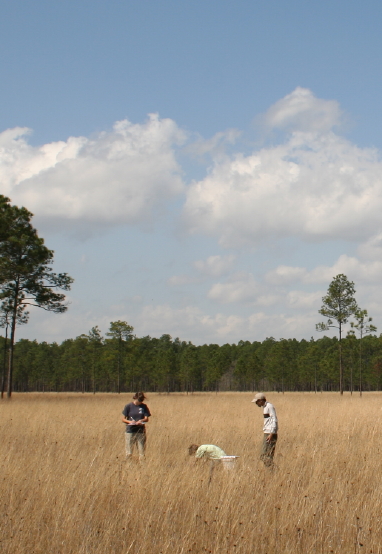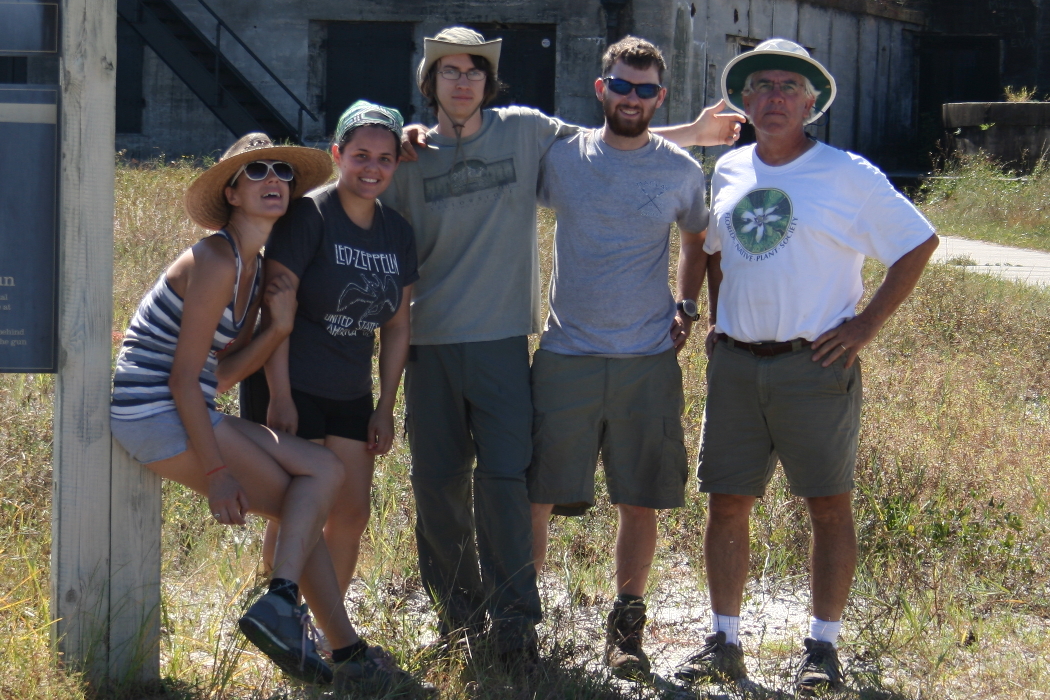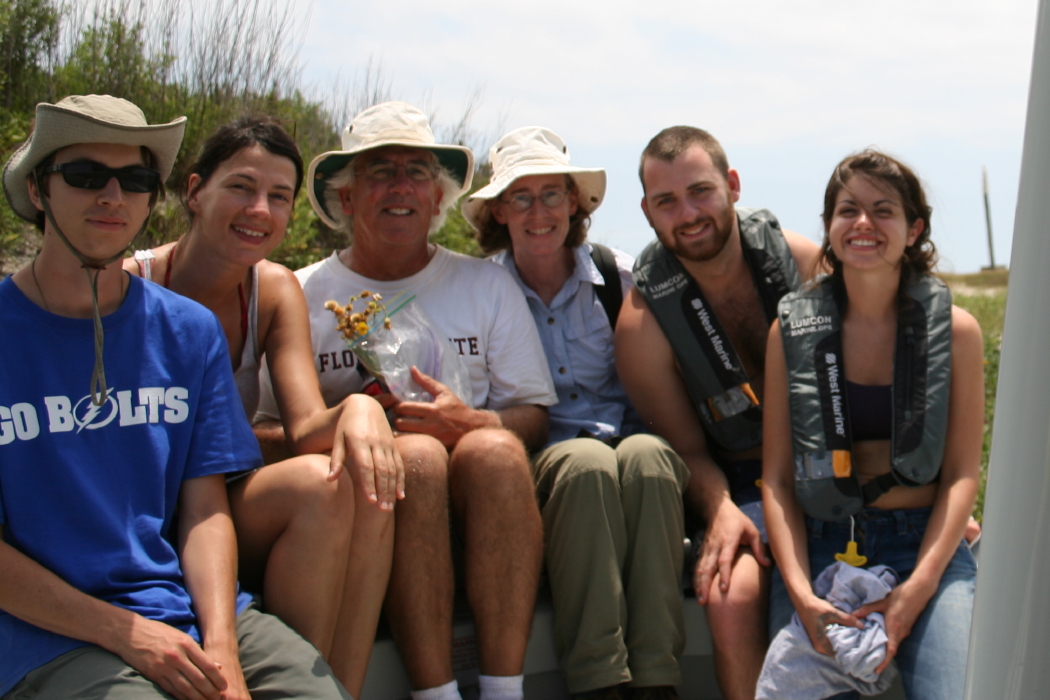Metacommunities
in the pitcher plant, Sarracenia purpurea
In the
last 15 years, ecologists have recognized that population
and community patterns are determined by both local species
interactions, as well as larger patterns of migration and
extinction occuring across larger heterogeneous regions. This
work was built on earlier ideas about patch dynamics and migration,
and has recently led to newer theory and experiments brought
together under a loose theory of "metacommunities."
We have
been testing a number of recent theories about community patterns
across metacommunities, as well as developing some theory
of our own. This work has taken advantage of the unique natural
microcosms found in the water-filled leaves of the purple
pitcher plant, Sarracenia purpurea (see Miller
and Kneitel 2005 for a review). The leaves of this carnivorous
plant attract insects that drown in the contained water, ultimately
providing nutrients for the plant. However, these prey insects
also serve as the basis for an aquatic community that lives
in the leaves. Bacteria break down the insects, while serving
as a resource for protozoa, rotifers, and mites. These bacteriovores
are in turn consumed by the larvae of a specialist mosquito,
Wyeomyia smithii. A
variety of other specialist species also depend on Sarracenia
purpurea, including two other dipterans (Metriocnemus
knabi and Fletcherimyia fletcheri and a specialist
moth herbivore, Exyra fax.
 Our
current work in this system has been in two areas, both supported
through grants from the National Science Foundation. First,
we have teseted theory on how the effects of migration in
metacommunities depends on the heterogeneity among local communities
with a large region. We completed a series of experiments
in which we manipulated both the migration rates and the among-leaf
heterogeneity. In general, we found that migration rate does
increase diversity, confirming earlier theory and experiments.
However, metacommunity heterogeneity had no effect on diversity,
contrary to a theory we earlier proposed. We are looking further
at the individual species patterns to see if we can explain
the mechanisms behind these results.
Our
current work in this system has been in two areas, both supported
through grants from the National Science Foundation. First,
we have teseted theory on how the effects of migration in
metacommunities depends on the heterogeneity among local communities
with a large region. We completed a series of experiments
in which we manipulated both the migration rates and the among-leaf
heterogeneity. In general, we found that migration rate does
increase diversity, confirming earlier theory and experiments.
However, metacommunity heterogeneity had no effect on diversity,
contrary to a theory we earlier proposed. We are looking further
at the individual species patterns to see if we can explain
the mechanisms behind these results.
 Second,
we are very interested in the evolutionary processes that
occur with this community, especially as they relate to species
diversity. These communities provide a natural system in which
to follow the evolution of competing species. The evolution
of competitors has been of long-standing interest in ecology
and evolutionary biology; this interest has again come to
the forefront due to questions about evolution of niche-partitioning
vs. equivalence and nuetral theory. We followed the evolution
of competitive ability and predator tolerance among a suite
of protozoa during 17 weeks of succession in naturally occuring
communities found in pitcher plant leaves. Niche theory would
predict that each species should evolve to utliize some unique
suite of resources, thereby reducing its interactions with
competitors. A neutral theory view would predict that at least
some species might evolve to have increased effects on one
another as they converge on the same niche. Our preliminary
results confirm neither of theise predictions. Instead, some
sort of frequency dependent selection seems to occur in which
poor competitors evolve to become better competitors, while
better competitors evolve to have reduced competitive effects
on other species. This "Robin Hood" effect of the
rich getting poorer and the poor getting richer has not previously
been described and may require a new look at current theory.
Second,
we are very interested in the evolutionary processes that
occur with this community, especially as they relate to species
diversity. These communities provide a natural system in which
to follow the evolution of competing species. The evolution
of competitors has been of long-standing interest in ecology
and evolutionary biology; this interest has again come to
the forefront due to questions about evolution of niche-partitioning
vs. equivalence and nuetral theory. We followed the evolution
of competitive ability and predator tolerance among a suite
of protozoa during 17 weeks of succession in naturally occuring
communities found in pitcher plant leaves. Niche theory would
predict that each species should evolve to utliize some unique
suite of resources, thereby reducing its interactions with
competitors. A neutral theory view would predict that at least
some species might evolve to have increased effects on one
another as they converge on the same niche. Our preliminary
results confirm neither of theise predictions. Instead, some
sort of frequency dependent selection seems to occur in which
poor competitors evolve to become better competitors, while
better competitors evolve to have reduced competitive effects
on other species. This "Robin Hood" effect of the
rich getting poorer and the poor getting richer has not previously
been described and may require a new look at current theory.
Long-term
Vegetation Dynamics on Barrier Islands in the Gulf of Mexico
Barrier
island provide very harsh environments for plants, as they
are highly disturbed with soils that are often saline, nutrient
poor, and subject to extremes in water availability. Such
islands occur along over 70% of the northern Gulf of Mexico,
as well as along most of the eastern US coast and are important
for ecological and economic reasons. They support a number
of unique plant species, while serving as breeding areas for
a number of birds and marine organisms. Barrier islands also
serve as important buffers that protect more inland areas
from both normal wave-action and storms. Finally, they are
also serve as a coastal "canary in the mine" for
observing and understanding the effects of global climate
change related to storms and sea-level rise.
 We
are involved in two projects on St. George Island, appoximately
60 miles SW of Tallahassee. First, we initiated a long-term
study of the vegetation dynamics on the island in 1998.
An annual census is conducted each fall, along with other
studies to periodically monitor dune dynamics and characteristics.
This long-term study suggests that dune vegetation is strongly
affected by two very different types of climatic events: spring
droughts and early fall tidal surge associated with major
storms (Miller, Gornish, and Buckley
2010). Second, we used this long-term database to quantify
how different species are likely to respond following storms,
with the goal of identifying the best species to use for coastal
restoration following storms. With funding from the U.S. Fish
and Wildlife service and the Apalachicola National Estuarine
Research Reserve, we have completed a small restoration project
on St. George to test the efficacy of different species for
restoration and conservation.
We
are involved in two projects on St. George Island, appoximately
60 miles SW of Tallahassee. First, we initiated a long-term
study of the vegetation dynamics on the island in 1998.
An annual census is conducted each fall, along with other
studies to periodically monitor dune dynamics and characteristics.
This long-term study suggests that dune vegetation is strongly
affected by two very different types of climatic events: spring
droughts and early fall tidal surge associated with major
storms (Miller, Gornish, and Buckley
2010). Second, we used this long-term database to quantify
how different species are likely to respond following storms,
with the goal of identifying the best species to use for coastal
restoration following storms. With funding from the U.S. Fish
and Wildlife service and the Apalachicola National Estuarine
Research Reserve, we have completed a small restoration project
on St. George to test the efficacy of different species for
restoration and conservation.

|
 |
Everything
changed in 2010. The Deepwater Horizon oil spill resulted
in oil residue occurring over a significant portion of the
Northern Gulf of Mexico. While some of this oil was in the
form of surface slicks or tar balls that were observed on
vegetation and beaches, much is thought to be in much lower
concentrations that may persist for years. Little is known
about the effects of such long-term exposure on natural ecosystems.
Our work
on St. George Island provided us with the experience and background
data to conduct the long-term censuses necessary to  determine
if such effects do or do not occur. With funds from NSF and
the Northern Gulf Institute, we have now initiated six additional
long-term study on barrier islands spread across the northern
Gulf of Mexico. These sites are approximately 160 km apart
along a gradient of oil exposure and include Trinity Island
(LA), Horn Island (MS), Santa Rosa Island
determine
if such effects do or do not occur. With funds from NSF and
the Northern Gulf Institute, we have now initiated six additional
long-term study on barrier islands spread across the northern
Gulf of Mexico. These sites are approximately 160 km apart
along a gradient of oil exposure and include Trinity Island
(LA), Horn Island (MS), Santa Rosa Island  (FL),
East Crooked Island (FL), Anclote Key (FL),and Cayo Costa
(FL), all censused using the methods developed for the on-going
census on St. George Island, FL.
(FL),
East Crooked Island (FL), Anclote Key (FL),and Cayo Costa
(FL), all censused using the methods developed for the on-going
census on St. George Island, FL.
Our
plan is to continue to monitor these seven barrier island
sites for the next 5 years, with the dual goals of quantifying
possible effects of the Deepwater Horizon oil spill and learning
more about the basic natural history of these important coastal
habitats. More information about these sites can be found
on the barrier islands research webpages,
which are constantly under construction. All of the data are
also available through these pages or by contacting us directly.
Many
thanks to our hardworking crews, including Elise Gornish,
Loury Migliorelli, John Mola, Jackie Monge, John Owenby, Abigail
Pastore, Chelse Prather, and Alice Winn. For further information
about any of these topics, please contact
T. Miller.
 Our
current work in this system has been in two areas, both supported
through grants from the National Science Foundation. First,
we have teseted theory on how the effects of migration in
metacommunities depends on the heterogeneity among local communities
with a large region. We completed a series of experiments
in which we manipulated both the migration rates and the among-leaf
heterogeneity. In general, we found that migration rate does
increase diversity, confirming earlier theory and experiments.
However, metacommunity heterogeneity had no effect on diversity,
contrary to a theory we earlier proposed. We are looking further
at the individual species patterns to see if we can explain
the mechanisms behind these results.
Our
current work in this system has been in two areas, both supported
through grants from the National Science Foundation. First,
we have teseted theory on how the effects of migration in
metacommunities depends on the heterogeneity among local communities
with a large region. We completed a series of experiments
in which we manipulated both the migration rates and the among-leaf
heterogeneity. In general, we found that migration rate does
increase diversity, confirming earlier theory and experiments.
However, metacommunity heterogeneity had no effect on diversity,
contrary to a theory we earlier proposed. We are looking further
at the individual species patterns to see if we can explain
the mechanisms behind these results. Second,
we are very interested in the evolutionary processes that
occur with this community, especially as they relate to species
diversity. These communities provide a natural system in which
to follow the evolution of competing species. The evolution
of competitors has been of long-standing interest in ecology
and evolutionary biology; this interest has again come to
the forefront due to questions about evolution of niche-partitioning
vs. equivalence and nuetral theory. We followed the evolution
of competitive ability and predator tolerance among a suite
of protozoa during 17 weeks of succession in naturally occuring
communities found in pitcher plant leaves. Niche theory would
predict that each species should evolve to utliize some unique
suite of resources, thereby reducing its interactions with
competitors. A neutral theory view would predict that at least
some species might evolve to have increased effects on one
another as they converge on the same niche. Our preliminary
results confirm neither of theise predictions. Instead, some
sort of frequency dependent selection seems to occur in which
poor competitors evolve to become better competitors, while
better competitors evolve to have reduced competitive effects
on other species. This "Robin Hood" effect of the
rich getting poorer and the poor getting richer has not previously
been described and may require a new look at current theory.
Second,
we are very interested in the evolutionary processes that
occur with this community, especially as they relate to species
diversity. These communities provide a natural system in which
to follow the evolution of competing species. The evolution
of competitors has been of long-standing interest in ecology
and evolutionary biology; this interest has again come to
the forefront due to questions about evolution of niche-partitioning
vs. equivalence and nuetral theory. We followed the evolution
of competitive ability and predator tolerance among a suite
of protozoa during 17 weeks of succession in naturally occuring
communities found in pitcher plant leaves. Niche theory would
predict that each species should evolve to utliize some unique
suite of resources, thereby reducing its interactions with
competitors. A neutral theory view would predict that at least
some species might evolve to have increased effects on one
another as they converge on the same niche. Our preliminary
results confirm neither of theise predictions. Instead, some
sort of frequency dependent selection seems to occur in which
poor competitors evolve to become better competitors, while
better competitors evolve to have reduced competitive effects
on other species. This "Robin Hood" effect of the
rich getting poorer and the poor getting richer has not previously
been described and may require a new look at current theory. We
are involved in two projects on St. George Island, appoximately
60 miles SW of Tallahassee. First, we initiated a
We
are involved in two projects on St. George Island, appoximately
60 miles SW of Tallahassee. First, we initiated a 
